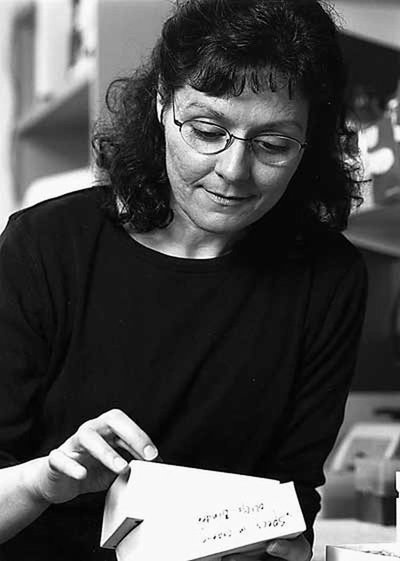November 1, 2001
Neuroscientist Bajjalieh studies the fundamental molecular steps in nerve cell function
By Pamela Wyngate
HS News & Community Relations
A certain doctor shakes my office when he tromps down the hall every day in full bicycle gear. The first time I heard this, my desk shook and I jumped. Months later, when the Nisqually earthquake happened, I didn’t immediately react because I had learned to ignore my lead-footed neighbor through a type of simple learning called habituation.
Dr. Sandra Bajjalieh, assistant professor of pharmacology, studies the molecular events that are altered with habituation and other kinds of learning.
“We don’t have a complete molecular picture of learning and memory,” she says. “But we’re picking up hints along the way by studying the basic process of neurotransmission.”
In the nervous system, billions of neurons (nerve cells) communicate by releasing and reacting to chemicals called neurotransmitters. The process is known as neurotransmission.
“Learning and memory are based in changes in neurotransmission-in many cases in how much neurotransmitter is released,” says Bajjalieh. “We are trying to understand the molecular mechanisms that produce and regulate the release of neurotransmitters and eventually how the process is altered to produce learning.”
Neurotransmitters are contained in little packages, or vesicles, in neurons. An electrical impulse within the neuron instigates a series of biochemical events that causes vesicles to fuse with the cell membrane, thus releasing their content of neurotransmitter. Specific molecules control the ability of vesicles to fuse. Bajjalieh’s group is focusing on synaptic vesicle protein 2 (SV2), a protein on neurotransmitter vesicles. SV2 appears to control the ability of vesicles to fuse in response to a nerve impulse.
“When we first cloned SV2, its structure predicted that it should be moving things across the vesicle membrane, maybe filling vesicles with neurotransmitter,” explains Bajjalieh. “Well, it doesn’t do that. My group started looking at SV2’s interaction with other proteins and found an interaction suggesting that it might control neurotransmitter release. At that point we had to step back and not be biased in our attempt to figure out its function.”
By examining what happens to neuronal functioning when SV2 is missing, they discovered that SV2 is absolutely essential for normal neurotransmission. Animals cannot live without SV2 because their nervous and endocrine systems do not function normally.
“You don’t need SV2 to get vesicles to fuse, but rather to fuse at the right time, in response to a nerve impulse,” says Bajjalieh. “It’s part of what contributes to the precise regulation of vesicle fusion in nerve cells.”
Bajjalieh presents the Science in Medicine New Investigator Lecture, “The Molecular Basis of Neurotransmitter Secretion” at noon on Thursday, Nov. 8, in Turner Auditorium-room D-209 of the Health Sciences Center. The lecture, which was originally scheduled for Oct. 11, was rescheduled to avoid a conflict with the UW’s Day of Reflection and Engagement.
Bajjalieh received her Ph.D. in neuroscience from the University of Wisconsin, Madison in 1989, and was awarded the Jerzy Rose Award in Graduate Research for her thesis work. From 1989 to 1994 she was a postdoctoral fellow with Professor Richard H. Scheller at Stanford University, where she received a U.S. Public Health Service National Research Service Award in 1989 and was a Howard Hughes Medical Institute associate from 1992 to 1994.
Bajjalieh came to the UW Department of Pharmacology in 1995. She received the Pharmaceutical Manufacturer’s Association Research Award in 1995, was an Alfred P. Sloan fellow from 1995 to 1997 and a Whitehall fellow from 1997 to 2000.



